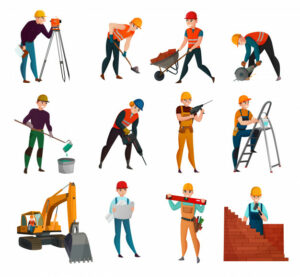
What Causes Back Pain
Back pain is caused by many things. Conditions commonly thought to cause back pain are muscle or ligament strain, repeated heavy lifting, occupational postures, a sudden awkward movement or trauma, skeletal irregularities, osteoporosis etc., etc., etc. The number of causes of back pain is infinite.
Let’s look at some worldwide statistics on back pain from two mainstream health organizations and see what these studies indicate in regard to back pain trends. These statistics (or lack of) demonstrate a pattern that back pain is mostly associated with what are considered Western, developed, or high income countries. The countries where Type 1 postural habits and lifestyle are common and encouraged, if not enforced.
This from NIH/National Library of Medicine: “The literature on the epidemiology of low back pain is accumulating but for the most part studies are restricted to high income countries which comprise only 15% of the worlds population. Little is known about back ache in the rest of the world.” (NIH, Epidemiology of Low Back Pain)
Why is Little Known In the Rest of the World?
Is little known about back pain in “the rest of the world” because back pain is little known, or non existent, in the rest of the world? Or is the “rest of the world” where Type 1 postural habits and the straight chair are uncommon?
Also from the same NIH site: “Within the categories of low income versus high income countries low back pain rates vary two fold or more. In comparisons between these categories of countries, rates on the whole are higher among the general populations of selected high income countries than among rural low income populations; specifically rates are 2 to 4 times higher among Swedish, German and Belgium general populations than among Nigerian, southern Chinese, Indonesians, and Filipino farmers. Within low income countries, rates are higher among urban populations than among rural populations and still higher among workers in particular worksites, referred to as ‘enclosed workshops’.”
From these studies it seems rates are higher among all high income urban populations: populations that habitually stand, walk or sit in a Type 1 posture.
The last sentence in the NIH study paragraph states: “Within low income countries urban rates are higher than among the rural population and still higher among workers in particular worksites.” Should this sentence read: Within low income countries rates of backache are higher among more Westernized, more developed, higher income urban populations than among their rural counterparts?
What Is An Enclosed Workshop?
What is an “enclosed workshop”? Is it someplace where working conditions and postural habits are comparable to Western, developed, or high income countries? Probably.

Does an “enclosed worksite” resemble clothing manufacturers in western, developed, or low income “urban populations”?
NIH deduction: “Conclusion: The higher rates in urban low income populations as compared with rates in rural low income populations and the sharply higher rates among workers in enclosed workshops of low income countries suggest a disturbing trend: low back pain prevalence may be on the rise among vast numbers of workers as urbanization and rapid industrialization proceed.”
The absence of statistics or documentation from non developed countries contributes evidence reinforcing the idea that a Type 1 postural lifestyle is clearly responsible for the prevalence of low back pain. It also provides clues as to the possible course of action to resolve this problem of worldwide back pain.
Another common expert approach to the problems with back pain from the World Health Organization is: “Low back pain is a common problem worldwide and a major cause of disability. It affects performance at work and general well being. Low back pain can be chronic, acute or sub acute. Though several risk factors have been identified (including occupational posture, depressive moods, obesity, body height and age) the causes of the onset of low back pain remain obscure and diagnosis difficult to make. Back pain is not a disease but a constellation of symptoms. In most cases the origins remain unknown.” (World Health Organization)

Statistics Indicate Developed Countries Cause or Contribute to Low Back Pain.
The cause or causes of back pain remain unknown or “obscure” only if a lot of statistics and documentation is overlooked. In the illustration at right the figures are all operating machinery repetitively, appear to have the knees locked back, and are in an unbalanced position. All are standing or working in a way that will cause or contribute to low back pain. There is nothing “obscure” about it from a Perfect Posture or balance orientation.
What Experts Seem to Overlook, Ignore, or Avoid
Most mainstream health care experts on back pain repeat a similar approach. When it comes to back pain experts overlook,ignore or avoid the way we stand, sit, and walk in developed countries.
Don’t buck industrialization apparently is the motto with the experts.
Millions of Americans have chronic back pain. It’s the leading cause of disability in people under 45. It’s much the same in all industrial nations.
The lifetime prevalence of low back pain in industrial nations is estimated to be up to 70%. (www.who.int). Therefore up to 7 out of 10 people in developed countries experience low back pain in their lifetime. () It appears that industrialized or developed countries are focal points for Type 1 sitting, standing, and work habits. Sit up straight!
It’s a safe assumption to make that non industrialized or undeveloped countries do not have chronic low back problems. They don’t have straight chairs either. The alternative hypotheses is that people from these countries have flocked to developed countries to throw off their back pain statistics.

Statistics suggest this woman will not have back pain. They also suggest she sits on or near the ground when she goes home, not a straight chair.
In Summary:
No studies that I could find indicate low back pain is prevalent or even exists in low income, undeveloped, poorer countries where a Type 2 or balanced postural habit is practiced.
So unlock your knees. Relax your shoulders vertical to your knees. Let your belly out…it won’t go far if your knees are unlocked and the shoulders are vertical to the knees.
Get rid of your straight backed chairs or at least do some Perfect Posture friendly body movements or stretches to recover. Check out the Feldenkrais Institute: Feldenkrais Method.
I’ve been a nurse for 40 years so I’m no novice when it comes to lifting, standing and sitting in a Type 1 orientation. I’m also no novice to recovery processes when I’m able. I can’t count the times I’ve hurt my back and had to take time to stretch and recover at home. For more recovery ideas review any site promoting Yoga. Or check out the Alexander Technique: https://www.alexandercenter.com/
Stay tuned for movements, habits and insight on how to recover from a day of Type 1 ecology. Stay tuned for the latest on my own struggle with back pain and western postural habits.

